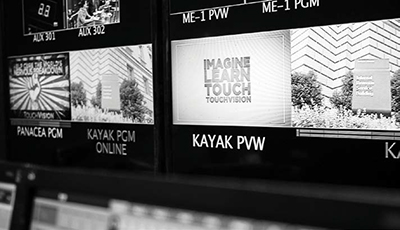News and Information for Millennials Plus

TouchVision editors at Chicago headquarters assemble stories into “Newsmovies” by mixing multiple raw video components from various news sources with music and narration.
CHICAGO—TouchVision is a fledgling video news and information service that has no anchors or reporters. It runs music under all its stories, no matter the subject— from train wrecks to a graphics-enhanced non-verbal feature on the latest price list for street drugs. It’s available 24/7 and most of its items are unfailingly brief: It’s to the traditional network newscast what Twitter is to Facebook.
Above all, TouchVision is geared to the “Millennials Plus” generation (ages 18-35) that has never lived in a world without digital technology and social media. The service can play out on four media platforms: linear TV, apps for smartphone and tablet, and its Web site. Launched last summer, it recently hired its 100th staffer at its Chicago headquarters.
‘NEWS MOVIES’
“We’ve identified and focus on a new mainstream of viewers and their information consumption habits, which are essentially wherever and whenever they want to know something,” said Steve Saslow, Touch- Vision’s co-founder and CEO. “And we’re leveraging the growth of smart, screen-based devices that are converging with the power of information. It’s an interesting and unique time for a new kind of offering.”
TouchVision receives raw footage from a wide range of sources such as AP, CNN, Reuters and Getty, where mostly young editors subsequently “storyboard” the stories into “News Movies” for viewing. Saslow said editing equipment includes state-of-the-art video and sound production tools, workstations and studios “designed to create a compelling look, sound and attitude.”
TouchVision has its fingers crossed its digital broadcast/cable component will expand rapidly from its current two markets. It began programming in July in Milwaukee (WDJT-TV multicast Channel 58.4, Time Warner Cable Channel 984, and Charter Channel 966) and plans to enter Chicago in early 2014 via cablers Comcast, AT&T, WOW and RCN.

A confluence of all of TouchVision’s video sources can be accessed at each edit station in the Ingestion room. A sampling of stories viewed in a recent week did not include any commercial spots, but TouchVision says it plans to announce some major advertising partners in early 2014. “Advertisers benefit by reaching an engaged and influential viewer on their terms within their lifestyle,” Saslow said.
The professional video industry's #1 source for news, trends and product and tech information. Sign up below.
Jim Hall, former vice president/general manager of WDJT-TV (and currently a vice president at Weigel Broadcasting in Chicago), said WDJT’s carriage of TouchVision as a 16:9 SD multicast channel was simply based on the strategic partnership that developed between the two companies. “We were a perfect match for TouchVision, given our experience with digital multicasting.”
WDJT-TV currently has one HD and three SD channels. “We use a Harmonic Electra 8141 encoder configured for ‘HD plus 3 SD,’” Hall said. “Our inputs are all SDI and the output is ASI, and our picture quality is excellent on all streams.” All four digital channels are carried by Time Warner Cable and Charter Cable.
“I believe it’s important that broadcasters really maximize their broadcast spectrum with multiple programming streams,” Hall said. “It gives broadcasters the ability to provide a wide range of programming to viewers and offers an excellent platform for additional ad revenue. TouchVision adds a unique sales option for us, and that’s reaching viewers across multiple screens— broadcast, desktop, smart phones and tablets. TouchVision allows a client the ability to buy all four screens at once… a single point-of-purchase to buy both broadcast and digital platforms.”
GETTING THE WORD OUT
TouchVision has a promotion campaign now underway in 18 markets and currently claims a collective audience approaching about 1 million monthly, while it faces competition from a growing list of other “Millennial Plus” start-ups—including VICE, Fusion, Now This News, and Pivot—not to mention long-established competitors.
James McQuivey, principal analyst at Forrester Research and author of “Digital Disruption: Unleashing the Next Wave of Innovation,” said “people want digital access, they want news, and TouchVision aims to give them both. However, it turns out people have plenty of news sources now— ranging from [Jon Stewart] to their Twitter feeds, and that’s going to be a challenge for TouchVision to overcome. TouchVision appears to want to focus on a younger style of news, but it should be warned: Al Gore already failed with that once when his Current TV channel flopped because younger people don’t spend a lot of time on traditional news, which TouchVision seems a lot more like than not,” McQuivey said.
Still, McQuivey adds, “news provides continuous content opportunities and it’s something that nearly all people value. By targeting news, TouchVision is borrowing a page from CNN—one of the early and most successful models for introducing a new content channel.”
TouchVision Co-founder/CCO Lee Abrams said his service is not really competitive with traditional TV news, per se, and likens it to the gradual emergence of FM a few decades ago. “A giant AM station targeted an older audience with a comfortable, older-skewing position,” Abrams said. “[Then] many smart AM operators mobilized their FM to target younger audiences with a more radical and edgy approach. Combining their FM and AM now gave the two stations enormous demographic range without sacrificing or overlapping. We see the same scenario today.”
TouchVision’s growing staff represents a “United Nations of skill-sets, ages and backgrounds,” according to Abrams, including journalists, internet aggregators, filmmakers, graphic artists, narrators and content managers.
“News and information is the new rock and roll,” Abrams added. “It used to be a hit song and a Walkman. Now it’s a big story and a tablet.”
A sample of TouchVision’s stories can be viewed at http://touchvisiontv.com/slot5.html.
